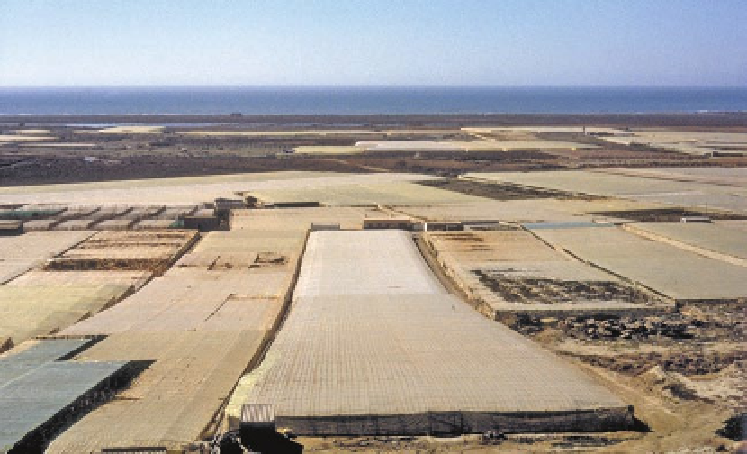Agriculture Reference
In-Depth Information
Photo 1.9.
Plastic greenhouses in the Poniente area in Almeria; plastic greenhouses in Spain represent
nearly 99% of the total greenhouse area.
In Japan, the leading country in green-
house production in the past, glasshouses
represented only 5% of the total area (Ito,
1999). Similarly, in China the majority of
greenhouses are those with plastic covers;
there has been a spectacular growth in these
since 1980 - their surface area in 2010 stood
at 1,496,000 ha, of which over half belonged
to the 'lean-to' type (see Fig. 7.5 in Chapter 7)
and the rest to high (2.5-3.0 m ridge height)
and middle (1.8-2.5 m ridge height) tun-
nels, while the glasshouse area was minimal
(Zhibin, 1999; Zhang, 2006; Kan
et al.
,
2012). The figures for tunnels can vary as
they can be erected or dismantled based on
production needs from year to year (Kan
et al.
, 2012).
Glasshouses were in majority only in
some areas of North America and in
Northern Europe, where they represented
90% of the surface in Germany and up to
98% in The Netherlands, for a total of less
than 25,000 ha within the European Union
(Von Elsner
et al
., 2000a,b).
(the use of plastic materials in agriculture)
was a consequence of the development of
new plastic materials that coincided with a
series of circumstances in agriculture (the
need to decrease investment costs and to
secure the harvests, and the scarcity of
resources such as water).
Since the first plastic greenhouses, a
simple wooden structure covered with cel-
lophane built in 1948, the appearance of
polyethylene plastic film (a material previ-
ously used only in military applications) in
the 1950s in the US market and the assem-
bly in 1962 (in Israel) of the first drip irriga-
tion installation of a significant dimension
(10 ha), the expansion of plastic applica-
tions has been enormous, especially in
protected horticulture.
Among the advantages provided by
plastics worth noting are: (i) its lightness,
because of its low density (so for instance,
1 m
2
of polyethylene film of 25 mm thick-
ness covering a greenhouse weighs 100
times less than 1 m
2
of horticultural glass of
4 mm thickness); (ii) its good mechanical
resistance (e.g. to hail) as compared with
glass; (iii) its durability (it resists corrosion
by chemical agents such as fertilizers and
biological agents such as bacteria and fungi);
(iv) its safety for plants and animals; (v) its
1.6
Plastic Materials
Rather than the result of specific scientific
research work, the birth of 'plasticulture'

